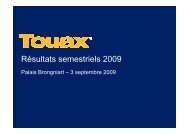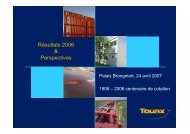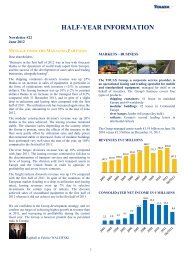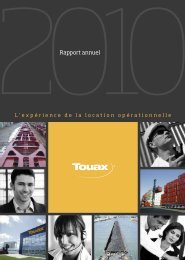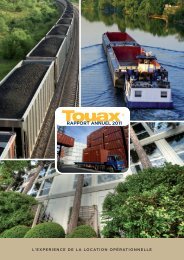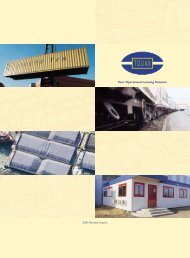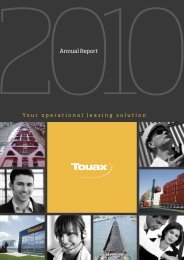2005 Annual Report - Touax
2005 Annual Report - Touax
2005 Annual Report - Touax
You also want an ePaper? Increase the reach of your titles
YUMPU automatically turns print PDFs into web optimized ePapers that Google loves.
<strong>Report</strong> of the Supervisory Board<br />
and of the Chairman of the Supervisory Board<br />
annual report <strong>2005</strong><br />
Objectives of the company with regard to internal<br />
control<br />
The purpose of the company’s internal control is to<br />
ensure that:<br />
2 management activities, general operations and<br />
personnel conduct comply with the guidance issued<br />
with regard to the company’s activities by the governing<br />
bodies of the company, the applicable laws and<br />
regulations and by the internal values, standards<br />
and rules of the company.<br />
2 the accounting, financial and management information<br />
provided for the governing bodies of the company<br />
accurately reflects the activity and position of<br />
the company.<br />
The procedures imply compliance with the management<br />
policies, protection of assets, prevention and<br />
detection of fraud and errors, the accuracy and<br />
exhaustiveness of accounting records, the provision<br />
of reliable accounting and financial information<br />
within the specified periods.<br />
The company’s internal control system does not,<br />
however, provide any certainty that the specified<br />
objectives will be attained, due to the limits inherent<br />
in any procedure.<br />
Summary of the risks borne by the company<br />
These risks, or one of these risks or other risks not<br />
currently identified or considered to be significant by<br />
TOUAX, could have a negative effect on the activities,<br />
financial position or results of TOUAX, or on its share<br />
price.<br />
The risks described in the report of the Managers<br />
are summarized in the following paragraphs.<br />
Financial risks<br />
The risks are market risks (interest and exchange<br />
rates), liquidity risk and equity risk.<br />
The management of financial risk forms an integral<br />
part of the management of the company. To provide<br />
improved risk monitoring and optimize internal<br />
controls, the management has separated the administrative<br />
and financial management into two parts:<br />
financial management and administrative and<br />
accounting management.<br />
The financial management, including the associated<br />
central cash management of the Group and administration<br />
of the management programs, manages<br />
the financial risk.<br />
All financial matters are monitored or reviewed daily<br />
by the financial management, which provides the<br />
necessary resources in order to limit the financial<br />
risks.<br />
The objective of the administrative and accounting<br />
management is to produce reliable accounting and<br />
financial information, to communicate such information,<br />
monitor other risks, in particular counterparty<br />
risk, establish administrative, accounting and<br />
financial procedures and monitor the legal and fiscal<br />
affairs of the Group.<br />
Legal risks<br />
The legal risks are monitored by the administrative<br />
and accounting management and by the operational<br />
directors.<br />
Provisions are created in respect of the risks as soon<br />
as an expense becomes likely in accordance with<br />
article L 123-20 article 3 of the Commercial Code.<br />
Industrial and environmental risks<br />
These risks relate particularly to economic, political,<br />
geopolitical, technological, climatic and environmental<br />
risks.<br />
They depend mainly on the various activities of the<br />
company. Regular reports are sent to the management<br />
to ensure that these risks are monitored.<br />
Dependence risk<br />
The Group has no significant dependence on any<br />
third party or public authority.<br />
Economic risk<br />
■ Shipping containers: the Group considers that due<br />
to the quality of its customer base it provides highquality<br />
services at competitive prices and that it therefore<br />
has significant strengths with which to<br />
confront the competition,<br />
■ Modular buildings: in order to limit these risks,<br />
the Group is on the one hand diversified into three<br />
distinct markets (building and public works, industry<br />
and local authorities), and on the other hand has<br />
passed on some of the risks to its own suppliers,<br />
■ Railcars: the Group believes that European<br />
governments will continue in the direction of deregulation<br />
and privatization, thereby increasing the<br />
competitiveness of rail transport and the volumes<br />
transported.<br />
Geopolitical risk<br />
■ Shipping containers: the geopolitical risk is the<br />
risk of a cyclical recession and the risk of protectionism.<br />
This risk is managed on the basis of an analysis<br />
of the breakdown into long-term and short-term<br />
leasing contracts,<br />
■ River barges: in the case of rivers which cross<br />
several countries (such as the Danube), there is a<br />
risk concerning the navigation fee (tax) which is<br />
charged to the units by the country to which the portion<br />
of the river belongs,<br />
■ Railcars: rail freight transport had been affected<br />
by problems of illegal immigration in the Channel<br />
Tunnel. Only around 5% of the fleet was allocated to<br />
this traffic in the first quarter of <strong>2005</strong>.<br />
Environmental risk<br />
■ Shipping containers: the Group has effected insu-<br />
136



